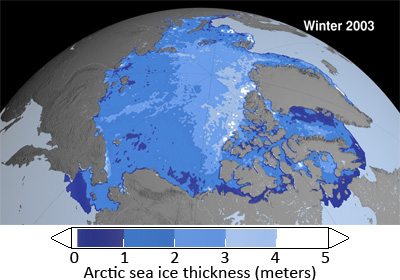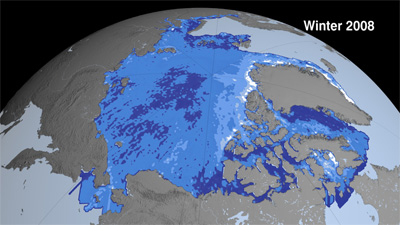mongabay.com, August 31, 2009
If current melting trends continue, the Arctic Ocean is likely to be free of summer sea ice by 2015, according to research presented at a conference in Nuuk, Greenland, organized by the National Space Institute at Technical University of Denmark, the Danish Meteorological Institute and the Greenland Climate Center.
The estimates, which are consistent with some models presented at the American Geophysical Union meeting in 2007 and research published last year, are based on the rapid thinning (loss of volume) of Arctic sea ice, which has outpaced shrinkage in extent of sea ice, in recent years. Last month NASA announced that overall Arctic sea ice thinned about 17.8 cm (7 inches) a year, for a total of 67 cm (2.2 feet) over the four winters from 2004 to 2008. NASA said the total area covered by thick older ice that survives one or more summers ("multi-year ice") shrank 42% or 1.54 million km² (595,000 square miles), leaving thinner first-year ice ("seasonal ice") as the dominant type of ice in the region. The share of seasonal ice increased from 38% of the Arctic's total ice volume in 2003 to 68% in 2008.
  Data visualization of Arctic sea ice thickness, as measured by ICESat, shows the decline of the thickest ice (white, 4-5 meters thick) and increase in thinner ice (deep blue, 0-1 meter) from 2003 to 2008. Credit: NASA"s Goddard Scientific Visualization Studio. |
Environmentalists are concerned that the loss of summer sea ice could have dramatic implications for wildlife -- like polar bear and walrus -- that depend on pack ice for feeding. At the same time, some developers welcome declining ice cover in that it could make it easier to exploit the Arctic's rich mineral, oil and gas deposits. Melting has already triggered a scramble between Canada, Russia, the U.S., Denmark, Sweden and Norway over rights to seabed resources.
Greenland's ice sheet
Scientists at the conference in Denmark also reported a "rapid increase" in ice loss for the Greenland ice sheet, including the loss of some 1200 cubic kilometers' worth of ice over the past years. About 60% of the ice loss came from iceberg calving from glaciers, while 40% resulted from increased surface melting.
Researchers further reported that melting and calving is spreading across Greenland: "Up until now, the mass-loss has been concentrated in the southern part of the Greenland ice-sheet. And while the inland part of the ice sheet is still growing at a small rate each year, this rate is now also declining," according to a statement from the Technical University of Denmark.
Conference presenters also said there is evidence that Greenland's permafrost is thawing, raising the risk of increased greenhouse gas emissions from frozen methane deposits.
Link: http://news.mongabay.com/2009/0831-arctic.html







No comments:
Post a Comment